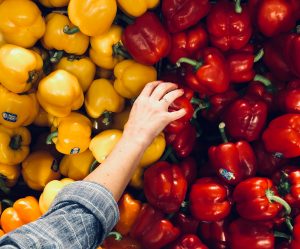Life as a Consumer and (New) Pet Owner in a Pandemic
Some of my most notable life experiences as a consumer in a pandemic fall under the consumer behaviour terms related to Perception (Sensory Systems) and the Individual Consumer Decision Making Process (Evaluation of Alternatives – and more specifically – Evoked set, Inept set, and, Inert Set). Each of these concepts will be discussed in more detail and I am sharing these experiences because of the significant impact they’ve had on my life.
Sensory Systems and Grocery Shopping During The Pandemic

Sensory marketing is described as “getting consumers involved in one or more of their senses by touching, feeling, smelling hearing, tasting, and hearing” (Niosi, n.d.). During the COVID-19 pandemic, I have had a difficult time selecting fruits and vegetables to purchase since many retailers have been prohibiting consumers touching them as per their COVID-19 store policies. Not being able to touch produce and physical grocery items before I made a purchase was a problem for me. I find it more difficult to differentiate between ripe and unripe produce. Overall, this lack of sensory interaction meant it took me longer to process my purchasing decisions and experience a higher degree of cognitive dissonance when I did not feel satisfied with my purchase. In this way, COVID-19 protocols have changed the way I shop and how the experience has deeply affected me.
Adopting a Dog During a Pandemic

Consumer hyperchoice is explained as “dilemmas that consumers face when they are making purchasing decisions that involve an excess amount of choice making it difficult or nearly impossible for consumers” (Niosi, n.d.). My experience with consumer hyperchoice comes from our family’s experience in choosing a dog to adopt during the pandemic. We wanted to make sure that the dog would be a good fit for our family and our household, however, it was difficult to agree on which type of dog would be the best fit. Our intention was to get a dog and use this time to bond and train it before returning to normal life. In my research, I discovered just how many different breeds of there are (many!) which made it difficult to narrow down the best for us. This inability to choose (hyperchoice) made me not want to get a dog at all. Having too many choices out there led me to becoming confused and not knowing what would be a great decision as I tend to struggle to make decisions when it comes to choices being laid out for me. Sometimes, it evens leads me to not making a final decision at all when it comes to the concept of consumer hyper choice. In the end, we choose a golden retriever and it has proven to be the perfect fit for our family.

Evoked set represents the alternatives being considered by consumers during the problem-solving process (Niosi, n.d.). My experience with evoked set was considering which kind of dog to adopt during the pandemic. Our family was only at specific dog breeds such as golden retrievers, labradoodles, and golden doddles. We didn’t consider any other breeds because at the end of the day, my brother wanted a golden retriever, my mother wanted a dog that would be smart and easy to train, and I wanted one that would be friendly and cute. We settled on a golden retriever puppy and we named him Chief.

Using this same experience, the inept set represents all those alternatives that we don’t consider as consumers when we’re evaluating alternatives during the problem-solving process (Niosi, n.d.). The breeds that we did not choose were German Shepards, Rottweiler, Doberman, Pitbull, and Chihuahua, etc. Essentially, we did not want breeds that had aggressive temperaments and that have a lot of barking and territorial issues. In other words, we were not interested in purchasing small dogs and very large dogs.
Finally, the inert set is expressed as the “brands that the consumer is aware of, but is indifferent and doesn’t consider them desirable or relevant which means that the consumer may exclude” (Niosi, n.d.). Using our dog adoption experience, our inert set might have included dog breeds that we were aware of, but we were strongly opposed to or in favour of. This would have included breeds such as border collies, beagles, and Australian shepherds.
By Ravi Vithlani (2021, August)
Media Attributions
- The image of a person’s hand reaching for peppers is by sydney Rae on Unsplash.
- The image of the golden retriever dog is by Camilo Fierro on Unsplash.
- The image of the golden doodle dog is by Bruce Williamson on Unsplash.
- The image of the German shepherd dog is by Nigel Tadyanehondo on Unsplash.
Text Attribution
- Niosi, A. (n.d.). Introduction to Consumer Behaviour is licensed under CC BY-NC-SA-4.0.
a small set of "go-to" brands that consumers will consider as they evaluate the alternatives available to them before making a purchasing decision.
the products which the consumer considers as a definite outsider.
the set of brands that a consumer has no opinion about, neither good nor bad.
getting consumers involved in one or more of their senses by touching, feeling, smelling hearing, tasting, and hearing.
dilemmas that consumers face when they are making purchasing decisions that involve an excess amount of choice making it difficult or nearly impossible for consumers.

